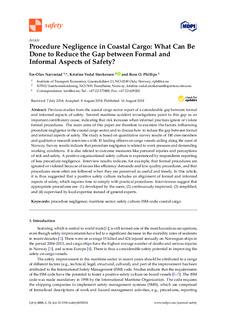| dc.contributor.author | Nævestad, Tor-Olav | |
| dc.contributor.author | Størkersen, Kristine Vedal | |
| dc.contributor.author | Phillips, Ross Owen | |
| dc.coverage.spatial | Norway | nb_NO |
| dc.date.accessioned | 2019-06-26T11:01:11Z | |
| dc.date.available | 2019-06-26T11:01:11Z | |
| dc.date.created | 2018-08-14T15:17:59Z | |
| dc.date.issued | 2018-08-14 | |
| dc.identifier.citation | Safety 2018, 4(3), 34 | nb_NO |
| dc.identifier.issn | 2313-576X | |
| dc.identifier.uri | http://hdl.handle.net/11250/2602289 | |
| dc.description.abstract | Previous studies from the coastal cargo sector report of a considerable gap between formal and informal aspects of safety. Several maritime accident investigations point to this gap as an important contributory cause, indicating that risk increases when informal practices ignore or violate formal procedures. The main aims of this paper are therefore to examine the factors influencing procedure negligence in the coastal cargo sector, and to discuss how to reduce the gap between formal and informal aspects of safety. The study is based on quantitative survey results of 180 crewmembers and qualitative research interviews with 10 leading officers on cargo vessels sailing along the coast of Norway. Survey results indicate that procedure negligence is related to work pressure and demanding working conditions. It is also related to outcome measures like personal injuries and perceptions of risk and safety. A positive organizational safety culture is experienced by respondents reporting of less procedure negligence. Interview results indicate, for example, that formal procedures are ignored or violated because of issues like efficiency demands and low-quality procedures, and that procedures more often are followed when they are perceived as useful and timely. In this article, it is thus suggested that a positive safety culture includes an alignment of formal and informal aspects of safety, which requires time to comply with practical procedures. Interviewees suggest that appropriate procedures are: (1) developed by the users, (2) continuously improved, (3) simplified, and (4) supervised by local expertise instead of general experts. | nb_NO |
| dc.description.abstract | Procedure Negligence in Coastal Cargo: What Can Be Done to Reduce the Gap between Formal and Informal Aspects of Safety? | nb_NO |
| dc.language.iso | eng | nb_NO |
| dc.publisher | MDPI | nb_NO |
| dc.relation.uri | http://www.mdpi.com/2313-576X/4/3/34/htm | |
| dc.rights | Navngivelse 4.0 Internasjonal | * |
| dc.rights.uri | http://creativecommons.org/licenses/by/4.0/deed.no | * |
| dc.title | Procedure Negligence in Coastal Cargo: What Can Be Done to Reduce the Gap between Formal and Informal Aspects of Safety? | nb_NO |
| dc.title.alternative | Procedure Negligence in Coastal Cargo: What Can Be Done to Reduce the Gap between Formal and Informal Aspects of Safety? | nb_NO |
| dc.type | Journal article | nb_NO |
| dc.type | Peer reviewed | nb_NO |
| dc.rights.holder | © 2018 by the authors. Licensee MDPI, Basel, Switzerland. | nb_NO |
| dc.description.version | publishedVersion | nb_NO |
| cristin.unitcode | 7482,2,3,0 | |
| cristin.unitname | Sikkerhet og organisering | |
| cristin.ispublished | true | |
| cristin.fulltext | original | |
| cristin.qualitycode | 1 | |
| dc.identifier.doi | 10.3390/safety4030034 | |
| dc.identifier.cristin | 1602018 | |
| dc.source.journal | Safety | nb_NO |
| dc.source.volume | 4 | nb_NO |
| dc.source.issue | 3 | nb_NO |
| dc.source.pagenumber | 1-23 | nb_NO |
| dc.relation.project | Norges forskningsråd: 250298 | nb_NO |

